Black-winged Kite (Elanus caeruleus) – A Local Invasion, October 2021
An attempt to draw together this extraordinary local occurrence with the situation nationally. Could this be the next UK colonist?
In this context ‘local’ means the area within about 30kms of Bernier (36). Bernier lies close to the convergence of three departements, the Vienne (86), the Haut-Vienne (87), and the Indre (36).
GALLERY - Photos of the event in chronological order.
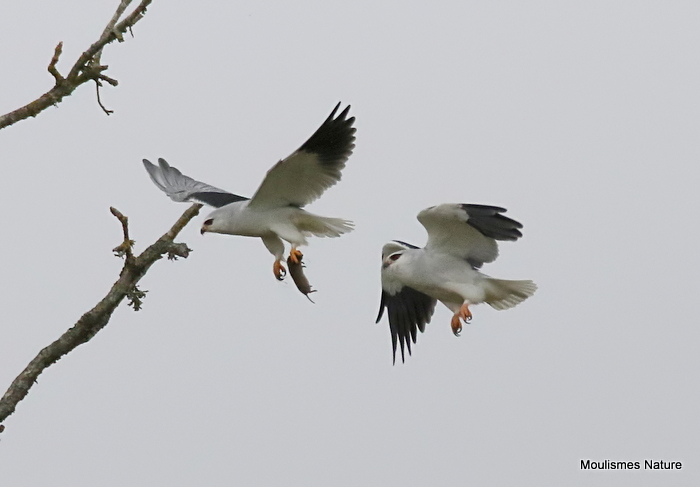
Mid-air food-pass. Most food exchanges were made whilst both birds were perched
Background
The remarkable range expansion of this most beautiful of raptors has been well documented. Originally from sub-Saharan Africa and southern Asia, the African population has spread through Spain and into France. From the first breeding record in France (1990, Pyrénées-Atlantiques) to a population approaching 150 pairs in 2014, expansion continues into northern departements. In 2016, one pair bred as far north as Rennes, Ille-et-Vilaine (35), constituting the first breeding record for Brittany.
Currently this is still a localised species around Bernier, but is becoming increasingly common.
In the Vienne (86) in 2020, up to fifteen pairs were recorded in the north, and at least three pairs elsewhere in the south and west.
Unlike most raptors, pairs can raise two broods per year; it may also seemingly breed at any time of year. Being a nomadic and eruptive species, one can expect sightings nowadays in any month. With an ample supply of voles in rural France, these are presumably the prime reasons for the phenomenal range expansion. Voles are thought to represent 95% of their diet (Mendelsohn &
Jaksić 1989).
The Situation Locally
Black-winged Kites have probably bred locally for several years.
The first nest I observed was in July 2020 in the commune of Thollet (86), just 9 kms from Bernier. That pair produced three flying juveniles by late September. By mid-October the juveniles had departed, the two adults remaining throughout the winter. By late March 2021 they then began to use the same nest, and the breeding cycle appeared to have started again.
Lockdown obs were difficult, but this pair seemed to have disappeared despite fairly frequent visits to search for them.
The first sign of a large dispersal of adults and immatures from local nest sites occurred on 4th October near Azat-le-ris (87). By the 18th up to eight birds could be seen at this site, with a further five only 7kms away in the commune Brigueil-le-Chantre (86). On the 19th a newly discovered pair were found in the commune Coulonges (86), just 3.84kms from the ‘dispersal site’ at Brigueil-le-Chantre, and 11.04kms from the nest site/dispersal site at Azat-le-ris.
Working on known brood averages, the dispersal site at Azat-le-ris was certainly the collective centre of at least two nesting pairs, probably three. Two pairs are known about for sure.
Both these groups dispersed within a few days.
The pair at Coulonges were fairly easy to observe from the car, as they were on a minor road.
I watched this pair from discovering them on 19th October until 12th November. Interestingly I use this road frequently throughout the year, and had failed to notice them before! By the 19th they already had at least one fledgeling in the nest. They are clearly very secretive when on eggs.
From reference sources, incubation time is > 28 days, chicks remaining in the nest > 35 days.
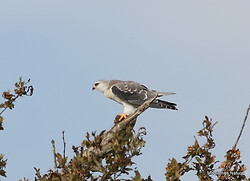
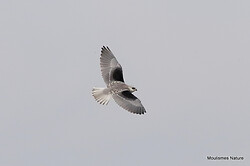
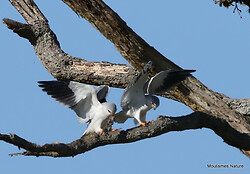
Juvenile plumage juv2 and a perched food-pass
Habitat
The habitat favoured here is unremarkable, mostly flat, the fields are either cultivated, pasture or left fallow, sometimes in rotation.
The two key requirements appear to be;
1. Availability of voles.
2. A scattering of dead/partially dead/living trees (with some dead branches exposed) used as vantage posts and nest sites. These are usually oaks here, and lie along hedgerows or where hedgerows used to be. Perhaps this superficially resembles the cork oak dehesas of Spain and Portugal and the scattered trees of the African savannah.
However, see comment below under 'Possible consequences for the UK... a future colonist?'....
Observational Notes
Abbreviated notes from the dispersal site at Azat-le-ris (87) in early October;
Partial moult of first juvenile plumage (juv1) thought to be after just three months to a transitional juvenile plumage (juv2). Only juv2 plumage observed at this site. Plumage juv2 hard to distinguish from adult from below, when darkish smudges to tips of tail feathers can be barely discernable. At this age dull brown iris colour is a useful feature (deep red in adults).
Abbreviated notes on a pair observed locally near Coulonges (86) from 19th October until 12th November. On discovery, the pair already had at least one hatched young.
19/10/21 – Much vocalization, mainly from the male. A squawking call, recalling Jay or even a parakeet sp. and a more tuneful 'chew-ee' call recalling Ringed Plover. A soft 'chup chup chup' call maybe from the female. The male caught a vole which was decapitated then given to the female.
22, 25/10/21 – More material added to nest. The male successfully caught voles every 10-15 minutes and gave them to the female (sometimes after decapitation), when both were perched. Only one mid-air exchange of prey item noted, very close to nesting tree.
26/10/21 – Both adults briefly started to build another nest in the same nest tree! One juvenile almost fully fledged. Plumage juv1 variable and may not show much colour on upper breast. The adults copulated fairly often.
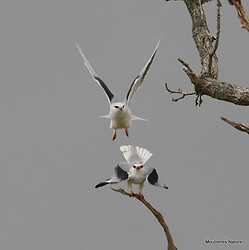
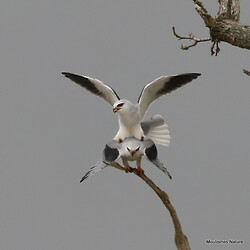
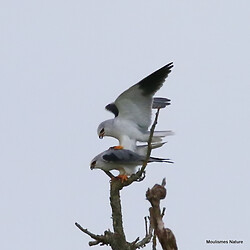
Frequent copulation
2/11/21 – Brief flight by first juvenile, a second fledgeling evident in nest. Problems with Magpies trying to steal prey item (s) when male perched, usually two Magpies approaching one from each side. Another brief mid-air food pass. Copulation less frequent.
6/11/21 – Male hunting further away from nest, two mid-air food passes. Oldest juvenile still perched on nest, no flight in 1.5 hours. The resident pair of Kestrels nearby gave the nest tree a wide birth, but hunted the same fields.
8/11/21 – Both juveniles using nest, the second gaining feathers. No sign of the adult male. The female briefly harassed by two Jackdaws, who in turn were chased off by two Carrion Crows.
9,10/11/21 – The presumed adult male was found hunting 1km away from nest. Maybe the delivery of prey items is far less frequent now.
11/11/21 – Still no sign of (visiting?) adult male, the female feeding the juveniles, the eldest of which has progressed to an outer branch of the nest tree. The presumed male found in what may be the original nest site of this pair 2kms away near Thollet (86).
12/11/21 – The adult female and two juveniles at nest tree, one juvenile flying briefly. No sign of aggression between siblings noted, concurring with BWP 'Some evidence of amicable bond between siblings' (Brown and Amadon 1968; N J Collar).
At this point I had to abandon the observations as the parking area was becoming used more frequently by farm workers.
'♂ provisions ♀ and young in early stages but does not normally feed chicks directly... ♂ brings food to ♀ who feeds young, bill-to-bill. Later both parents hunt but feeding normally still done exclusively by ♀ until young able to feed themselves from food in nest.' (BWP). My observations concurred with this.
Interestingly virtually no aggression by the adult kites towards kestrels was noted, or vice-versa, over feeding or nesting territory, unless a kestrel came very close to the nest tree. Surprising when both species were hunting voles almost exclusively. The Kestrels often hunted over the same field.
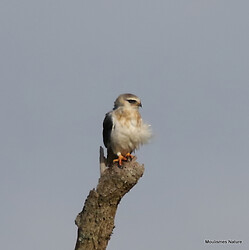
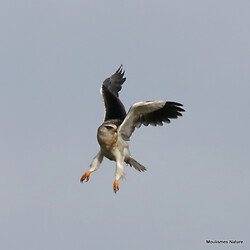
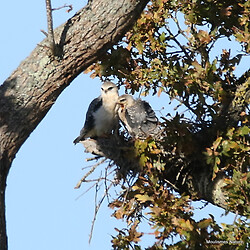
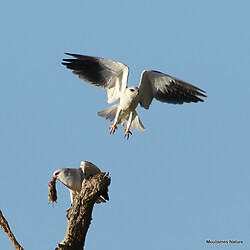
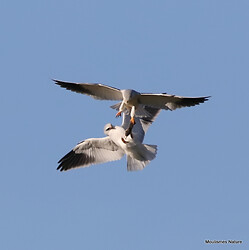
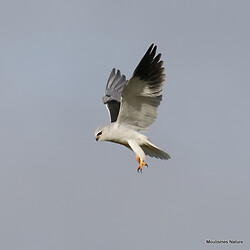
From top left to right, etc; Plumage juv1/plumage juv1/the two youngsters/perched food-pass/mid-air food-pass/adult hunting
Possible consequences for the UK... a future colonist?
Some recent sightings of relevance.
Guernsey in 2018 (one), Alderney (one) 2020. Alderney is 16kms from the French coast, 90kms from the nearest part of the UK coast.
So far there have been four records in Sweden, with thirteen in Denmark, to 2016. The narrowest crossing point there being just 4kms.
The narrowest crossing point Europe to Morocco is about 15kms.
The narrowest crossing point UK to France is 34kms.
Presumably then it would not take a great leap of faith to make the 34kms to the UK.
Availability of food (voles).
The Kestrel population in UK has declined since the mid-seventies. Recently the population has fluctuated but with a general downward trend, current UK conservation listing is amber (source BTO). If changes in agricultural practice have reduced the habitat for its prey species, voles, then maybe the outlook for colonisation by Black-winged Kites doesn’t look so promising. France quite simply has lots of ‘vacant' farmland not always cultivated by farmers, or (loosely) used as pasture or for silage.
Favoured habitat.
The favoured habitat here bears little resemblance to that used in, for example, Israel (another country with a Black-winged Kite population explosion). In which case either the breeding habitat isn't such an important factor, or those in Israel have adapted.
Reference sources
Black-winged Kite in the Western Palearctic: increase in breeding population, vagrancy, and range.
Lukasz Lawicki/Yoav Perlman. Jan 2017.
Birds of the Western Palearctic (BWPi), Oxford University Press (OUP), 1994 >
BTO, BirdTrends, Kestrel. 2019.
The Raptors of Europe and the Middle East: A Handbook of Field Identification. Dick Forsman. May 2000.
Birds Of Prey Of Britain & Europe. Benny Gensbol. 1986.
Collins Bird Guide 2nd edition. Svensson, Mullarney, Zetterstrom, Grant. 2009.
Thanks to Christophe Mercier, co-ordinator (birds) at Faune Limousin (Limoges, 87), for information regarding the situation historically in that departement.
In this context ‘local’ means the area within about 30kms of Bernier (36). Bernier lies close to the convergence of three departements, the Vienne (86), the Haut-Vienne (87), and the Indre (36).
GALLERY - Photos of the event in chronological order.

Mid-air food-pass. Most food exchanges were made whilst both birds were perched
Background
The remarkable range expansion of this most beautiful of raptors has been well documented. Originally from sub-Saharan Africa and southern Asia, the African population has spread through Spain and into France. From the first breeding record in France (1990, Pyrénées-Atlantiques) to a population approaching 150 pairs in 2014, expansion continues into northern departements. In 2016, one pair bred as far north as Rennes, Ille-et-Vilaine (35), constituting the first breeding record for Brittany.
Currently this is still a localised species around Bernier, but is becoming increasingly common.
In the Vienne (86) in 2020, up to fifteen pairs were recorded in the north, and at least three pairs elsewhere in the south and west.
Unlike most raptors, pairs can raise two broods per year; it may also seemingly breed at any time of year. Being a nomadic and eruptive species, one can expect sightings nowadays in any month. With an ample supply of voles in rural France, these are presumably the prime reasons for the phenomenal range expansion. Voles are thought to represent 95% of their diet (Mendelsohn &
Jaksić 1989).
The Situation Locally
Black-winged Kites have probably bred locally for several years.
The first nest I observed was in July 2020 in the commune of Thollet (86), just 9 kms from Bernier. That pair produced three flying juveniles by late September. By mid-October the juveniles had departed, the two adults remaining throughout the winter. By late March 2021 they then began to use the same nest, and the breeding cycle appeared to have started again.
Lockdown obs were difficult, but this pair seemed to have disappeared despite fairly frequent visits to search for them.
The first sign of a large dispersal of adults and immatures from local nest sites occurred on 4th October near Azat-le-ris (87). By the 18th up to eight birds could be seen at this site, with a further five only 7kms away in the commune Brigueil-le-Chantre (86). On the 19th a newly discovered pair were found in the commune Coulonges (86), just 3.84kms from the ‘dispersal site’ at Brigueil-le-Chantre, and 11.04kms from the nest site/dispersal site at Azat-le-ris.
Working on known brood averages, the dispersal site at Azat-le-ris was certainly the collective centre of at least two nesting pairs, probably three. Two pairs are known about for sure.
Both these groups dispersed within a few days.
The pair at Coulonges were fairly easy to observe from the car, as they were on a minor road.
I watched this pair from discovering them on 19th October until 12th November. Interestingly I use this road frequently throughout the year, and had failed to notice them before! By the 19th they already had at least one fledgeling in the nest. They are clearly very secretive when on eggs.
From reference sources, incubation time is > 28 days, chicks remaining in the nest > 35 days.



Juvenile plumage juv2 and a perched food-pass
Habitat
The habitat favoured here is unremarkable, mostly flat, the fields are either cultivated, pasture or left fallow, sometimes in rotation.
The two key requirements appear to be;
1. Availability of voles.
2. A scattering of dead/partially dead/living trees (with some dead branches exposed) used as vantage posts and nest sites. These are usually oaks here, and lie along hedgerows or where hedgerows used to be. Perhaps this superficially resembles the cork oak dehesas of Spain and Portugal and the scattered trees of the African savannah.
However, see comment below under 'Possible consequences for the UK... a future colonist?'....
Observational Notes
Abbreviated notes from the dispersal site at Azat-le-ris (87) in early October;
Partial moult of first juvenile plumage (juv1) thought to be after just three months to a transitional juvenile plumage (juv2). Only juv2 plumage observed at this site. Plumage juv2 hard to distinguish from adult from below, when darkish smudges to tips of tail feathers can be barely discernable. At this age dull brown iris colour is a useful feature (deep red in adults).
Abbreviated notes on a pair observed locally near Coulonges (86) from 19th October until 12th November. On discovery, the pair already had at least one hatched young.
19/10/21 – Much vocalization, mainly from the male. A squawking call, recalling Jay or even a parakeet sp. and a more tuneful 'chew-ee' call recalling Ringed Plover. A soft 'chup chup chup' call maybe from the female. The male caught a vole which was decapitated then given to the female.
22, 25/10/21 – More material added to nest. The male successfully caught voles every 10-15 minutes and gave them to the female (sometimes after decapitation), when both were perched. Only one mid-air exchange of prey item noted, very close to nesting tree.
26/10/21 – Both adults briefly started to build another nest in the same nest tree! One juvenile almost fully fledged. Plumage juv1 variable and may not show much colour on upper breast. The adults copulated fairly often.



Frequent copulation
2/11/21 – Brief flight by first juvenile, a second fledgeling evident in nest. Problems with Magpies trying to steal prey item (s) when male perched, usually two Magpies approaching one from each side. Another brief mid-air food pass. Copulation less frequent.
6/11/21 – Male hunting further away from nest, two mid-air food passes. Oldest juvenile still perched on nest, no flight in 1.5 hours. The resident pair of Kestrels nearby gave the nest tree a wide birth, but hunted the same fields.
8/11/21 – Both juveniles using nest, the second gaining feathers. No sign of the adult male. The female briefly harassed by two Jackdaws, who in turn were chased off by two Carrion Crows.
9,10/11/21 – The presumed adult male was found hunting 1km away from nest. Maybe the delivery of prey items is far less frequent now.
11/11/21 – Still no sign of (visiting?) adult male, the female feeding the juveniles, the eldest of which has progressed to an outer branch of the nest tree. The presumed male found in what may be the original nest site of this pair 2kms away near Thollet (86).
12/11/21 – The adult female and two juveniles at nest tree, one juvenile flying briefly. No sign of aggression between siblings noted, concurring with BWP 'Some evidence of amicable bond between siblings' (Brown and Amadon 1968; N J Collar).
At this point I had to abandon the observations as the parking area was becoming used more frequently by farm workers.
'♂ provisions ♀ and young in early stages but does not normally feed chicks directly... ♂ brings food to ♀ who feeds young, bill-to-bill. Later both parents hunt but feeding normally still done exclusively by ♀ until young able to feed themselves from food in nest.' (BWP). My observations concurred with this.
Interestingly virtually no aggression by the adult kites towards kestrels was noted, or vice-versa, over feeding or nesting territory, unless a kestrel came very close to the nest tree. Surprising when both species were hunting voles almost exclusively. The Kestrels often hunted over the same field.






From top left to right, etc; Plumage juv1/plumage juv1/the two youngsters/perched food-pass/mid-air food-pass/adult hunting
Possible consequences for the UK... a future colonist?
Some recent sightings of relevance.
Guernsey in 2018 (one), Alderney (one) 2020. Alderney is 16kms from the French coast, 90kms from the nearest part of the UK coast.
So far there have been four records in Sweden, with thirteen in Denmark, to 2016. The narrowest crossing point there being just 4kms.
The narrowest crossing point Europe to Morocco is about 15kms.
The narrowest crossing point UK to France is 34kms.
Presumably then it would not take a great leap of faith to make the 34kms to the UK.
Availability of food (voles).
The Kestrel population in UK has declined since the mid-seventies. Recently the population has fluctuated but with a general downward trend, current UK conservation listing is amber (source BTO). If changes in agricultural practice have reduced the habitat for its prey species, voles, then maybe the outlook for colonisation by Black-winged Kites doesn’t look so promising. France quite simply has lots of ‘vacant' farmland not always cultivated by farmers, or (loosely) used as pasture or for silage.
Favoured habitat.
The favoured habitat here bears little resemblance to that used in, for example, Israel (another country with a Black-winged Kite population explosion). In which case either the breeding habitat isn't such an important factor, or those in Israel have adapted.
Reference sources
Black-winged Kite in the Western Palearctic: increase in breeding population, vagrancy, and range.
Lukasz Lawicki/Yoav Perlman. Jan 2017.
Birds of the Western Palearctic (BWPi), Oxford University Press (OUP), 1994 >
BTO, BirdTrends, Kestrel. 2019.
The Raptors of Europe and the Middle East: A Handbook of Field Identification. Dick Forsman. May 2000.
Birds Of Prey Of Britain & Europe. Benny Gensbol. 1986.
Collins Bird Guide 2nd edition. Svensson, Mullarney, Zetterstrom, Grant. 2009.
Thanks to Christophe Mercier, co-ordinator (birds) at Faune Limousin (Limoges, 87), for information regarding the situation historically in that departement.